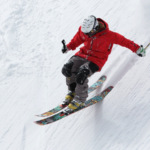The best thing is that it’s not in the way to install a stowable table in front of the pilots, which makes eating and doing paperwork in flight all the easier. Hell, you can even have a flight attendant on your lap if you fancy a macho way of getting fired from your airline.
Yet there are a lot of misconceptions about this sidestick, mainly by hardline Boeing fans who just don’t want to let go of that huge misfit between their legs… the big control column of course is what I am referring to here (what were you thinking of?).

(What a great way to fly this sidestick is. And it leaves room between pilot’s legs for more important objects… like a table for example. Note the red button which will be mentioned later.)
The sidestick works from the pilot’s point of view just like a joystick would work when you’re playing your favorite computer game: you pull it and the nose of the airplane moves up; you push it forward and the nose drops; you turn it to the left and the airplane banks to the left; and of course you turn it to the right and yes, you got it already.
However, what goes on behind the scenes is actually a bit more intriguing and it turns out that sidestick doesn’t really just do what pilots may ask of it.
Welcome to the world of fly by wire, where there are several independent and fancy computers that interpret what the pilot’s input is on this sidestick and deflect the control surfaces according to what they are best deflected to.
Contrary to conventional flying, the sidestick’s inputs don’t directly control a deflection of the control surfaces. Also unlike with conventional steering the flight control laws of the Airbus use “g”, the acceleration vector of earth’s gravity, as a demand norm in pitch. When a pilot lets the sidestick rest in neutral, the airplane will therefore assume he’s demanding 1 g from it [see note 1 for a surprising trivia]. That can be level flight but it can also be a constant rate of climb or so. [note 2]
In roll the sidestick asks a roll rate and in pitch it asks a load factor (like 1.05 times g), rather than a direct deflection of the surfaces. This is great for pilots who fly a smaller A318 one day and a bigger A330 the next: they feel the same, they handle the same and so you can be rated on both types at the same time – a big selling point for Airbus.

(The sidestick or the autopilot are the at basis of the control chain and their signals are interpreted by some flight control computers before these computers send further orders to the control surfaces. These computers don’t let pilots bust their safety limits on the Airbus. In fact the pilots are treated like kids: they can only go that far before mother Airbus has to stop them from harming themselves and others.)
One of the things Airbus doesn’t let pilots do with the sidestick is go outside of the flight envelope. That’s a fancy way of saying that they won’t be able to fly too fast or too slow, bank too much or pitch the airplane too much, or be too sporty and pull too many g loads. In short: if the pilots don’t behave the airplane won’t blindly follow the stick inputs.
So if you hold the sidestick full back and keep it there, the airplane will only let you pitch up so much before it knows you’re better suited for a desk job and starts ignoring your further demand to pitch up.
Similarly when you yank a full deflection to the left out of the stick, the airplane will first make it hard for you to maintain that by exerting a feedback force in the stick once you pass 33 degrees, and second you won’t be able to exceed 67 degrees, even if your mother is waving at you at 68 degrees bank and you want to wave back.
These rules are abandoned when the airplane somehow ends up in a really unusual attitude, so you can still recover. These rules work miracles when the pilots need to get away from the ground fast, in windshear or in ground proximity warnings, because they can just go full backstick without worrying about a stall.
Under the sidestick are a bunch of levers and artificial feel mechanisms that enable all this. The wires then continue to the flight computers from where other wires go to the hydraulic actuators of the flight controls. (Fly by WIRE, remember. Although you can’t fly without hydraulics.) Note that this artificial feel is not a feedback from the forces on the flight controls, like computer games may do.

(Below the sidestick are a bunch of springs and rods and solenoids and dampers and screws and bearings… that make this magic possible.)
Now what happens when your fellow pilot spills his hot coffee over the sidestick, short circuits the thing somehow or even makes the stick give weird and faulty inputs? Or what if he’s not the sharpest tool in the shed and he’s flying in a way that’s really starting to work on your nerves?
Well, you can press your little red round takeover pushbutton then. A sexy voice will come on saying “priority left/right” and there’s a red light that comes on in front of the pilot who’s stick is deactivated so that he sees he’s out of the loop. If the other stick is still giving inputs then there’s a green light coming on in front of him with his job title (Capt or F/O); this is the way to know when that spilled coffee is causing faulty inputs even though he’s pleading innocence and he isn’t touching the stick anymore.
If one pilot presses the red button for more than 40 seconds continuously, the other sidestick remains deactivated until the red button on it is pressed.
If both pilots are in a heated fight for control and both keep on pressing that button uninterruptedly then the captain in the left seat wins the fight and he’ll have control, otherwise it’s the last one who presses who gets control.

(Some flashy bulbs in frontal view of the pilots are related to the sidestick priority. A red arrow indicates your side is out of the loop. A green light tells you that you’re giving inputs. If both are on and you’re not touching your stick, it’s time to tell the other pilot he should press his button for 40 seconds because your stick is faulty.)
What if nobody presses any priority button and both pilots just do their own thing with their own stick? Then that sexy voice comes on again and says “dual input” and both the green lights with the job titles come on. (No red arrows because nobody took priority.)
What actually happens then is that the inputs are algebraically added and sent to the flight computers, who will still limit the airplane to the normal maximum bank, pitch etc…
So if one pilot goes full left and the other full right: nothing happens except the flashy bulbs and the sexy voice “dual input”.
If both pilots think full left is the way to go and both go full stop to that side the airplane will still limit its bank to the 67 degrees, but now with lights and sexy voice.
The red button also works as an autopilot disconnect button.
Even though the red button is called by Airbus the “instinctive takeover pushbutton”, a comment from pilots is often that it’s not all that instinctive to press in a stressful situation that requires prompt action, like the other guy messing up the landing. Since there’s no deflection on the other side of the cockpit you can’t feel what his inputs are. I’ll give Boeing guys the satisfaction to agree with them that this is the (only) criticism that has some ground. There… everybody happy now.
[note 1] Interesting fact that even most Airbus pilots don’t know: if you fly at cruise levels where g, the acceleration vector, has a smaller magnitude because you’re further away from earth’s center of gravity, the airplane actually enters a very shallow climb with neutral stick and manual flight to go after the 9.81 m/s^2.
[note 2] Oh… I completely forgot to mention that there’s no need to trim the airplane either. While you fly the airplane is trimmed automatically for you.
Why flights take longer?

Today, a non-stop flight from New York city to Houston, Texas takes about 3 hours and 50 minutes..In 1973, the same flight would have taken 2 hours and 37 minutes.
Why does it takes us longer to fly the same distance? The simple answer is FUEL EFFICIENCY
Airplanes are able to save millions per year by flying slower.
From 2002 to 2012 the price of fuel went up from $0.70 per gallon to over $3 per gallon. A 2008 associated press report said jetBlue saved $13.6 million a year by adding just under two minutes to each flight.
Fuel costs are also why airlines are attempting to make planes weigh as little as possible. That involves changes to the plane itself, and charging customers fees for heavy luggage.
Flights also seem longer because of a practice called BLOCK PADDING . Airplanes add a few minutes to the expected arrival time to seem more punctual.
So… do not be fooled when airlines say you’re arriving ahead of schedule!
Mark Zuckerberg just purchased two side-by-side mansions on Lake Tahoe totaling a whopping $59 million!
Why buy a lake house when you could buy an entire compound? Well if you’re a multi-billionaire like Facebook founder Mark Zuckerberg, it’s seems like a wise choice. The tech giant just purchased two side-by-side mansions on Lake Tahoe totaling a whopping $59 million, according to Variety.

While the price tag is higher than probably anyone could ever imagine paying for a vacation home, it’s just a kick in the bucket for a man valued around $70 billion. The pair of properties total around 10 acres, have a total of 15 bedrooms, and include numerous piers to house multiple boats. The smaller mansion, called Carousel Estate, is a charming Tudor-style home, built back in the early 1930s. The other house, called Brushwood Estate, was built in the ’60s and has two adjoining guest houses for visitors to enjoy. Want to take a tour? Read ahead to get a look at the billionaire’s lakeside escape.

Lush foliage provides a bit of privacy to the founder’s first estate.

The view from the home just might be worth that $59 mil.

The home’s exterior truly has a charming feel.

We have a feeling Zuck will have plenty of boats to dock up on the pier.





















386 thoughts on “How does the control joystick in Airbus aircraft work?”
Comments are closed.